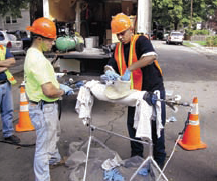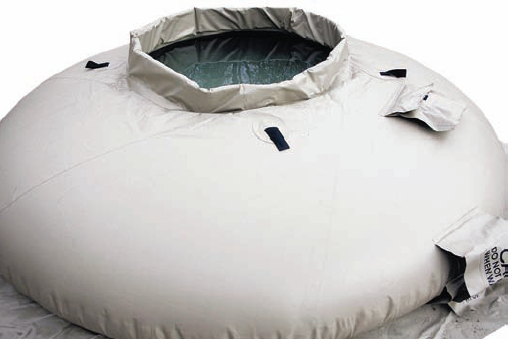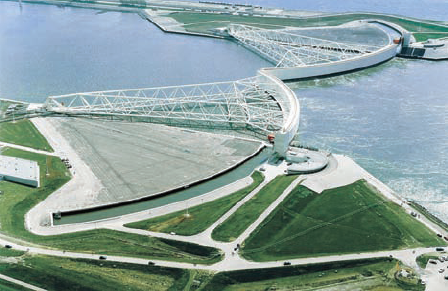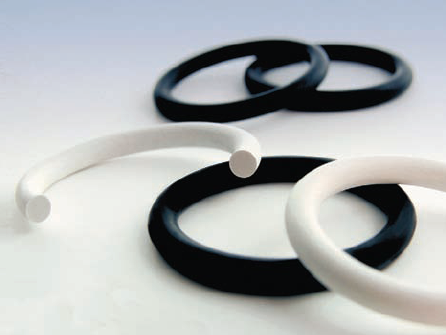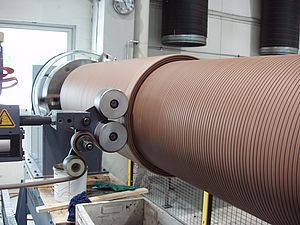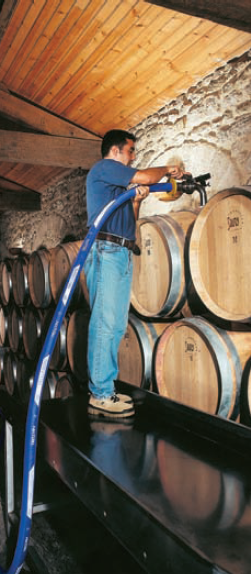In food production, polymers are at hand from the very beginning. In the cultivation of fields for crop growing, tires protect the soil from unnecessary damage. Once the crops are harvested and being processed, seals, millions of which are fitted throughout food processing systems, help prevent contamination, even in difficult and demanding dairy production. This is also the case for high technology hoses, which are regularly used by wine producers for all the best vintages. Finally, at the end of the manufacturing process, trucks equipped with damping solutions transport these essentials to consumers worldwide.
With regard to water-related products, rubber is vital in certain critical applications. Sealing products are used extensively in the treatment and transportation of drinking water. They range from large gaskets used in wastewater treatment plants and infrastructure, to tiny but equally important O-Rings found in faucets in homes. Globally, as the sea levels are rising land protection is of growing concern. Technology used for flood defense systems in flood-prone countries, such as the Netherlands, is being transferred to projects worldwide. In this type of application, rubber products help to waterproof foundations and divert watercourses.
Congested roads are also becoming an increasing problem, particularly around metropolitan areas. With little land to divert traffic to, underground road tunnels are becoming longer and larger. Gaskets are an integral part of these, preventing water ingress into underground arterial routes.Polymers are also present in a wide range of seawater applications, such as mooring systems that protect ships when docking in harbour. Subsea rubber and polymer products contribute to the safety of personnel and equipment involved in oil and gas exploration. One example is VIV suppression products that protect pipelines from the destructive vortex-induced vibrations caused by underwater currents.
Water-filled onions
Collapsible water storage containers can be supplied in two formats, either pillow shaped or ‘onion’ shaped. The pillow shaped tank is ideal for water and other aqueous solutions and has a standard capacity range of 3,700 to 75,000 litres, while the onion tanks are specifically designed for storage of potable and non-potable water and have a capacity range of 3,780 to 11,350 litres. The onion tank comes in three configurations – open top, roll top, to keep contamination out, and zipper top, which prevents both contamination and evaporation. Both formats are easily rolled up and transported and can be custom ordered to specific capacities. Pumps, hoses and water distribution sets are part of the solution, making the water containers suitable for both military authorities and relief agencies.
Processing food
In a processing plant, processing dairy products or other kinds of food, there are thousands of lengths of piping and at each juncture there is a coupling sealed with clamp gaskets and O-Rings. Ineffective sealing frequently results in production stops for maintenance, or even unplanned part replacements. Carefully matching the seal material to the process media and the aggressive chemicals used in cleaning regimes maximizes the life of seals and gaskets. This improves production efficiency, reducing overall costs for the manufacturer. From high-performance EPDM elastomer compounds to advanced materials, such as Resifluor and the perfluoroelastomer Isolast, the right sealing material for diverse operating conditions are available.
Mega gates block the flood
In one of the world’s largest flood prevention projects, the Delta Project in the Netherlands, the Maeslantkering storm-surge barrier protects the land from the powers of the water. The massive structure consists of two hollow “gates” with 248 one-meter-high fenders, constructed by Trelleborg Bakker. Each gate’s arm length is 237 meters, from ball joint to the tip. When the gates are folded into their two docks, each is supported by 14 spring-like elastomeric bearings. In the event of a storm tide, the docks are filled with water and the hollow gates start to float, and turn outwards until they meet. As the gates’ cavities are filled with water, the gates sink and seal off the 360-meter-wide water opening. After the high water has passed, the water is pumped out and the structure begins to float again. Once the risk of high water has passed, the two gates are returned to their docks. During a huge storm in November of 2007, the storm-surge barrier was closed for the first time. The barrier will only be closed in extremely bad weather – probably once every ten years.
Plug the water
Impregnated polyester fabrics and ethylene propylene diene monomer (EPDM) rubber are useful ingredients when fixing pipes. German company Trelleborg Epros, a niche leader in the after- market for pipe systems and sewer rehabilitation markets, acquired by Trelleborg in early 2007, specializes in trenchless repairs. Trelleborg Epros supplies systems and materials (polyester needle felts, chemical-resistant fiberglass) and resins to civil contractors to allow them to repair wastewater and storm water pipes without digging them up.
The product range of inflatable and flow-through pipe plugs, such as the DrainStopper system, is suited for stopping flows and for bypassing when inspecting pipes for leaks. The plugs’ flexible and gripping material can safely seal any pipe material and all inflatable plugs can be easily introduced through manholes. A pressure reducer is connected to an air source via an air hose, which is fitted with an actuator. Another air hose connects the system to the expansion plug, which is then placed into the pipe and inflated.
Polymer Products Used in Food and Water Applications
From deep seas to productive fields, polymer products and solutions help to seal, damp, and protect in water and food applications. Here are some examples of that happening in practice.
- by Trelleborg Industrial Solutions
- May 18, 2009
- 205 views


